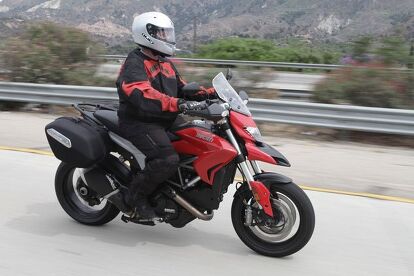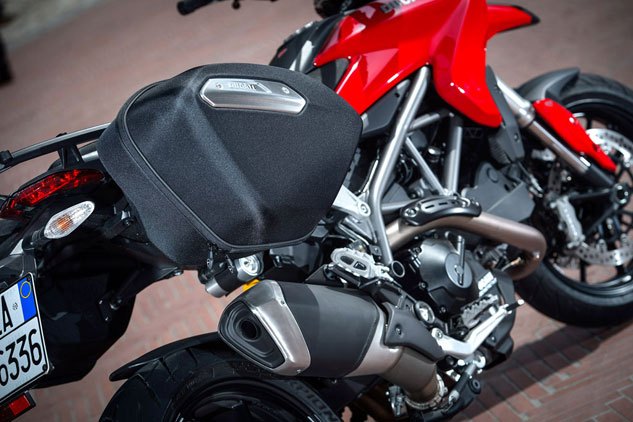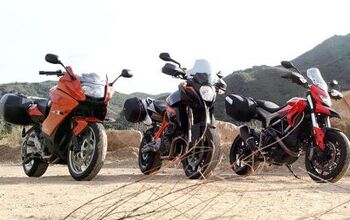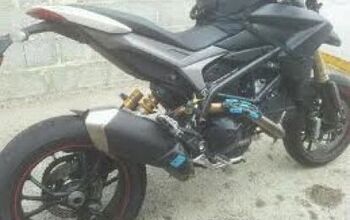2013 Ducati Hyperstrada Review
Ducati’s new-for-2013 Hyperstrada wheelies, slides the rear wheel, jumps curbs, is nimble and flickable, and a hoot in urban environments. Characteristics, according to Ducati, distance riders look for when considering a new model to go “touring, Italian style.”
Joining the Multi and Diavel, the Hyper brings Ducati’s current number of strada models to three. But whereas the Multistrada, from creature comforts to carrying capacity, is a true sport-tourer laden with superbike performance, and the Diavel Strada its performance-cruiser-tourer counterpart, the Hyperstrada is a thinly disguised supermotard with no serious touring convictions.
When compared directly to its Hypermotard stablemate, the Hyperstrada differs by way of a taller windshield, 20mm taller handlebars, a wider seat with thicker foam, 50-liter semi-rigid saddlebags, a centerstand, a passenger grab handle, larger front and rear mudguards, a bash plate and two 12V outlets.
Technical Differences
| Hypermotard | Hyperstrada | |
|---|---|---|
| MSRP | $11,995 | $13,295 |
| Tires | Pirelli Diablo Rosso II | Pirelli Scorpion Trail |
| Front Wheel Travel | 170 mm | 150 mm |
| Claimed Wet Weight | 436 lbs | 450 lbs |
| Seat Height | 34.2 in / 33.5 in | 33.5 in / 32.7 in |
| Wheelbase | 59.1 in | 58.7 in |
Most of these items are available as accessories to the standard Hypermotard, but the cost of accumulating all the individual pieces, plus installation, will assuredly run more than the $1,300 MSRP difference between the two bikes. Individually the accessories may serve the purpose of riders desiring a particular result, but as a package they do little to transform this motorcycle from motard to tourer.
Troy Siahaan rode the Hypermotard in Italy earlier this year
“The Hyperstrada was one of my most anticipated bikes of 2013, as I expected it to be a Multistrada Lite of sorts,” says Chief Tard, Kevin Duke. “However, the Hyper falls short of that lofty goal due to its confining seat and non-adjustable windscreen.”
The seat to which Duke is referring is a nicely contoured, form-fitting mount comfortable for short distances and keeps your arse in place during wheelies but allows no fore/aft movement, thus locking the rider into a single position. That position is dirtbike style, perched close to the motorcycle’s front end, and one we grew tired of after an hour in the saddle on the freeway with no corners in sight.
The Hyperstrada made it on our 10 Hottest Bike of 2013 list
On the bright side, the proximity to the Hyperstrada’s non-adjustable windscreen equates to better wind deflection than expected from the small, clear plastic piece. Long freeway rides at 80 mph require nothing more than a light grip on the handlebars as the majority of wind blast is diverted away from the rider.
Fuel Economy and Range
| Tank Capacity | Observed Average MPG | On-Board Computer Average MPG | Observed Average Range |
|---|---|---|---|
| 4.2 gal. | 41.5 mpg | 44.5 mpg | 174 miles |
At 32.7 inches, even the low version of the Hyperstrada (shorter suspension) is imposingly tall for some riders. An accessory low saddle further reduces seat height to 31.9 inches, but then you’re losing the extra padding of the touring seat.
“Another gripe is that the Hyperstrada’s footpegs are located just enough in the way of the sidestand that it is nearly impossible for five-foot-six-inch-me to get the stand down with any dexterity,” says guest tester, Scott Rousseau.
One thing we all agreed elevated the Hyperstrada to superstar motardism is its new 821cc Testastretta 11° V-Twin. Now with more than 18,000 miles between major service intervals, the new liquid-cooled, four-valve-per-cylinder motor also features independent throttle bodies for each cylinder and RbW throttle operation.
“Ducati’s new 821cc Twin is mostly delightful,” says Duke, “offering a broad range of power and an impressive 96 horses at the rear wheel.”
However, we did notice an imperfect EFI, where the engine seemed to be randomly searching for a constant flow of petrol, occasionally feeling as though it were on the cusp of running out of fuel. Also, of the three ride modes (Sport, Touring, Urban), in conjunction with a very light throttle return spring, we found the Sport setting too abrupt and hard to modulate. We settled on the Touring mode with the throttle set to Sport and engine power on full. “But even Touring mode exhibits a slight grumpiness and mild surging at very small throttle openings,” says Duke.
“The Ducati’s handling prowess is downright impressive, but there is a tradeoff to be endured, says Rousseau. “I think it may be a bit of stretch to call the Hyperstrada ‘twitchy,’ but it’s definitely nervous in a straight line, especially at freeway speeds over rippled pavement.”
We love the Hypermotard as the hooligan bike it’s meant to be, and the Hyperstrada expands the ‘Tard’s mission capabilities to include light touring and storage-equipped commuting. However, it falls short on delivering the sport-touring qualities of its Multistrada big brother. It excels as a sporty bike around town and in the canyons and is acceptable for a day on the road, but it’s not really a mini-Multi touring rig.
Ducati Hyperstrada Specifications
| MSRP | $13,295 |
| Engine Type | Testastretta 11°, 4-valve-per-cylinder Desmodromic, liquid cooled |
| Engine Capacity | 821cc |
| Bore x Stroke | 88 x 67.5mm |
| Compression | 12.8:1 |
| Fuel System | Magneti Marelli electronic fuel injection, 52mm throttle body with ride-by-wire |
| Horsepower | 96.6 @ 9400 rpm |
| Torque | 58.6 ft lb @ 7800 rpm |
| Transmission | 6 speed |
| Clutch | APTC wet multiplate with control cable |
| Final Drive | Chain |
| Frame | Tubular steel Trellis |
| Front Suspension | Kayaba 43mm usd fork |
| Rear Suspension | Progressive linkage with adjustable Sachs monoshock. Aluminium single-sided swingarm |
| Front Brakes | 2 x 320mm semi-floating discs, radially mounted Brembo M4-32 Monobloc 4-piston callipers with ABS |
| Rear Brakes | 245mm disc, 2-piston calliper with ABS |
| Front Tire | 120/70 ZR17 |
| Rear Tire | 180/55 ZR17 |
| Seat Height | 33.5 in / 32.7 in |
| Curb Weight | 450 lbs |
| Wheelbase | 58.7 in |
| Rake/Trail | 25.5° / 104 mm |
| Fuel Capacity | 4.2 gal |
| Electronics | Riding Modes, Power Modes, Ducati Safety Pack (ABS + DTC), RbW |
| Colors | Ducati red/racing grey/black or Arctic white/racing grey/black |
| Warranty | 2 years unlimited miles |
A former Motorcycle.com staffer who has gone on to greener pastures, Tom Roderick still can't get the motorcycle bug out of his system. And honestly, we still miss having him around. Tom is now a regular freelance writer and tester for Motorcycle.com when his schedule allows, and his experience, riding ability, writing talent, and quick wit are still a joy to have – even if we don't get to experience it as much as we used to.
More by Tom Roderick







































Comments
Join the conversation
The issue with the Hypermotard and Hyperstrada is that if you are anywhere near 6ft and above, you look like a circus bear riding a mini bicycle.
I don't know if they fixed it for 2014 but I ride mine in sport mode everywhere and have never had any problems, coolest 100 HP dirt bike I've ever had.